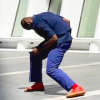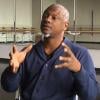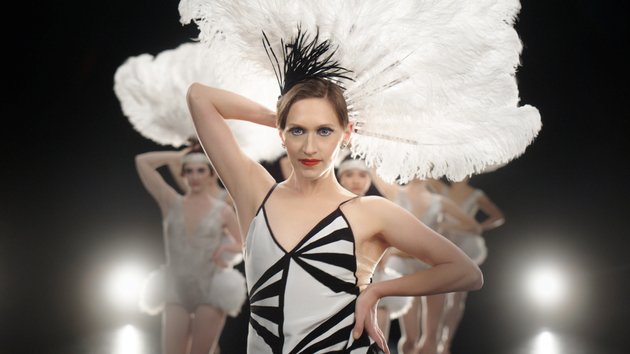
There’s an old saying, “Don’t take any wooden dimes.” If that sounds familiar, don’t blame the land down under for upping the ante. Here, it’s nickels, and there, it’s been adjusted for inflation. Same meaning — don’t trust in common currency. Don’t believe everything you hear. If it sounds too good to be true, it is.
And so it goes with Wooden Dimes, the new film by choreographer Danielle Rowe, the premiere on the third program of the San Francisco Ballet’s all-virtual season, available for viewing until March 24 through the Ballet’s website.
In the film, the rising vaudeville star Betty Fine (Sarah Van Patten) believes the blandishments of her besotted director (Tiit Helimets) and the sycophancy of her best friend, the wardrobe mistress (Ludmila Bizalion). Betty’s poor husband Robert (Luke Ingham), a civilian, is stuck behind a dead-end desk in a dead-end clerical job, surrounded by three workmates who want him to move faster, faster. He goes to pieces. She takes wooden dimes. Their love slows, stills, dies.
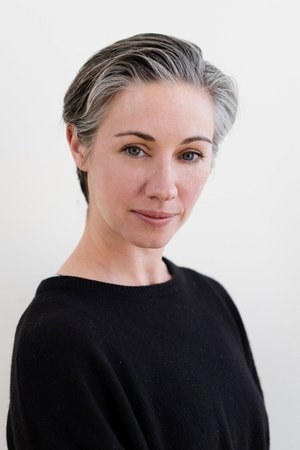
Rowe, from South Australia, danced with The Australian Ballet for a decade, leaving in 2011 to join Houston Ballet, quickly becoming a principal dancer. She went on to Nederlands Dans Theater, retired in 2017, and made her first ballet, For Pixie, for SFDanceworks. San Francisco Ballet Artistic Director Helgi Tomasson saw it and invited her to choreograph a small piece, UnSaid, for the company’s 2019 gala. Wooden Dimes is Rowe’s first ensemble piece for the company. Ingham, who also left Australia for Houston Ballet and then San Francisco, is Rowe’s husband. They have two children.
Wooden Dimes shares the program with two older and much admired works from the repertory: Symphony #9 (2014), excerpted from Shostakovich Trilogy, by Alexei Ratmansky, and The Swimmer (2015), by Yuri Possokhov. Both ballets were recorded using archival capture, which literally captures exactly what live audiences saw in the War Memorial Opera House, only more clearly. These are quite simply wonderful ballets.
They were not made to be filmed, but we can be grateful they were. The ballets were made with normal budgets in no pandemic. They were extensively rehearsed. The musicians were all in the same pit at the same time, rather than recording individually at home and then having their work produced in the studio (Music Director Martin West, incidentally, did a great job with Wooden Dimes). Those two ballets seem to leap off the screen, no matter how small that screen is.
Wooden Dimes is utterly different. Set to a score commissioned from James M. Stephenson by the San Francisco Ballet, it was made to be a film. The director of photography, Heath Orchard, was meticulous in setting up shots on the Opera House stage, scene by scene, sequence by sequence, working closely with the choreographer, who shot detailed video of each part of each sequence with her cell phone. This movie, filmed over a few days in early December 2020, was the fourth dance film Rowe has worked on since the pandemic began, she said.
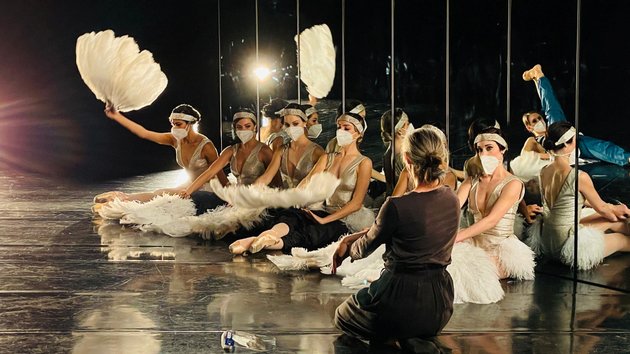
The dancers were limited as to the amount of time they could work together and restricted by rules about the cast size, the extent of contact, and the need for frequent Covid testing. The size of the crew was also limited.
Alexander V. Nichols’s highly stylized, 1920s dressing room setting is deliberately high contrast — angular blacks and whites; Emma Kingsbury’s black, white, and shimmery silver costume designs; and Jim French and Matthew Stouppe’s lighting — beginning with the bright, hypnotic whiteness of the ghost light, burning singularly onstage when everything else has been cleared off.
Into this space dance the leggy, upward-striving chorus girls, chattering vivaciously as they sit in their silvery costumes at their silvery makeup tables, looking into their light-framed mirrors.
When Betty’s handsome, hunky husband Robert arrives, the couple dances a marvelous, sweetly intimate pas de deux, wrapping closely together, their love and trust warming the chilly monotones of the surroundings.
But after that, it’s a downward slide. Back at his office, Robert is dwarfed by his huge wooden desk, pounded by his three militant, demanding, eyeshade-wearing workmates. He’s dragged off his wooden swivel chair, slides under his desk, and ends up a withered husk, a broken man.
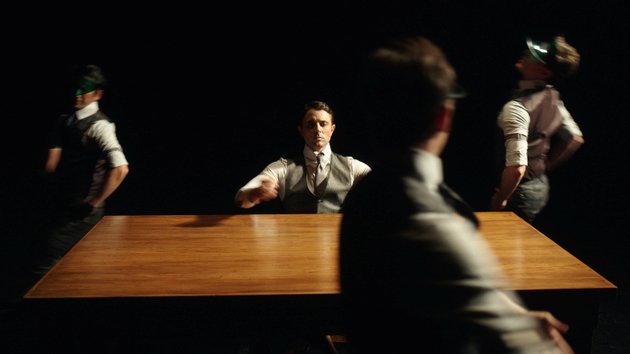
Meanwhile, backstage, although her costumes are growing slightly more colorful, Betty Fine’s joie de vivre is shrinking away. Through the camera’s lens, the light falls on her with particular harshness, and the angular planes of her face match her increasing air of an eagerness to please, coupled with desperation, as her marriage falls apart and she realizes that The Director is an empty suitor with empty promises. There can be no happy endings here.
Wooden Dimes feels uneven in terms of character development and choreographic elaboration. For instance, the Dark Angels (Dores André and Max Cauthorn), the knifelike duo that’s helping to wreck Robert’s self-confidence, fully embody a nasty pulse. The wages of sin are so much easier to portray than the virtues of success, particularly as embodied by Betty Fine, as she gets noticed and takes the spotlight. The choreography doesn’t tell us why she gets noticed; she dances aimlessly from here to there and there to here, filling time and space.
Equally inconclusive is a brief routine, shot from overhead, with the eight Chorus Ladies lying on the stage, twirling their fluffy ostrich fans overhead, Busby Berkeley fashion. The feathers don’t really add an aura of more dancers; the sparseness and lack of innovation takes on a pathos all its own. Wooden Dimes has a lot to say, but most of it remains unsaid. And finally, dime’s up.


